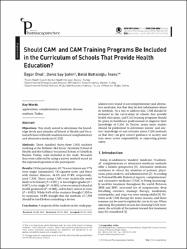Should CAM and CAM Training Programs Be Included in the Curriculum of Schools That Provide Health Education?
Özet
Objectives: This study aimed to determine the knowledge levels and attitudes of School of Health and Vocational School of Health students toward complementary and alternative medicine (CAM). Methods: Three hundred thirty-three (333) students studying at the Mehmet Akif Ersoy University School of Health and the Golhisar Vocational School of Health in Burdur, Turkey, were included in the study. Research data were collected by using a survey method based on the expressed opinions of the participants. Results: Of the participants, 69.7% were female and 97% were single (unmarried). Of cigarette users and those with chronic illnesses, 46.8% and 47.8%, respectively, used CAM. Those using CAM were statistically more likely to be female (P < 0.021), to have higher grades (P < 0.007), to be single (P < 0.005), to be vocational school of health graduates (P < 0.008), and to have fathers at work (P < 0.021). While 9.6% of the students thought CAM to be nonsense, 10.8% thought that the methods of CAM should be tried before consulting a doctor. Conclusion: A majority of the students in the study pop-ulation were found to use complementary and alternative medicine, but that they lacked information about its methods. As a way to address this, CAM should be included in the curriculum of schools that provide health education, and CAM training programs should be given to healthcare professionals to improve their knowledge of CAM. In Turkey, many more studies should be performed to determine nurses' and doctors' knowledge of and attitudes about CAM methods so that they can give correct guidance to society and take more active responsibility in improving patient safety.


















